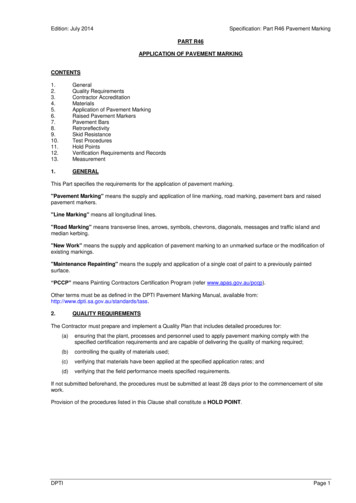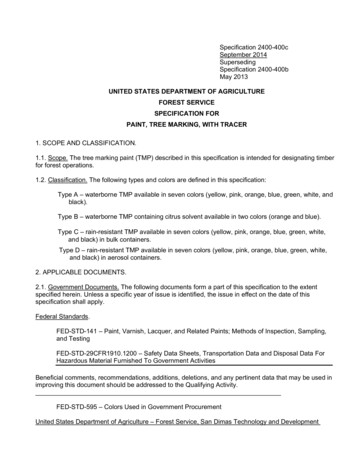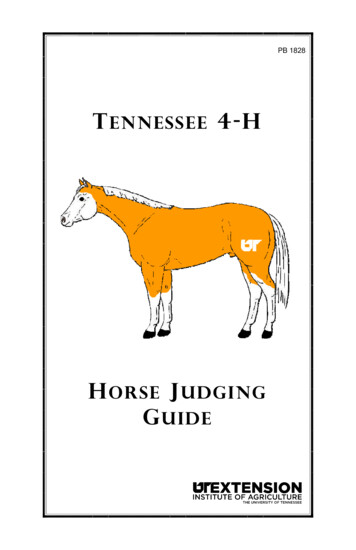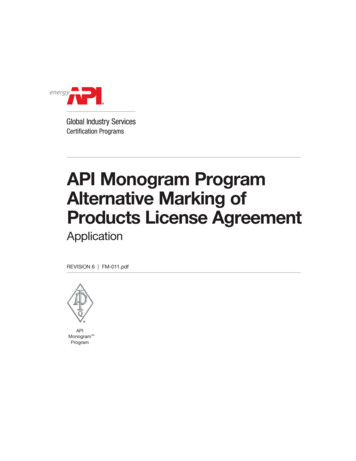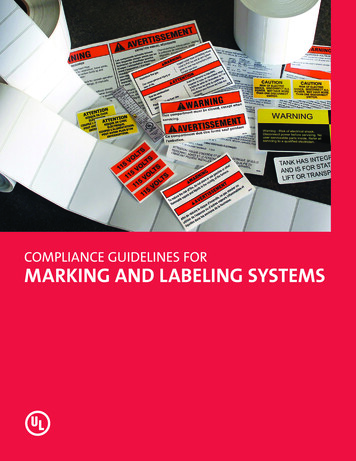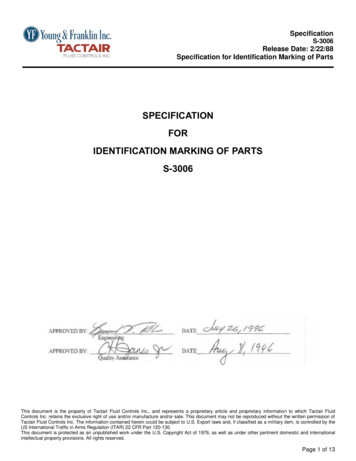
Transcription
SpecificationS-3006Release Date: 2/22/88Specification for Identification Marking of PartsSPECIFICATIONFORIDENTIFICATION MARKING OF PARTSS-3006This document is the property of Tactair Fluid Controls Inc., and represents a proprietary article and proprietary information to which Tactair FluidControls Inc. retains the exclusive right of use and/or manufacture and/or sale. This document may not be reproduced without the written permission ofTactair Fluid Controls Inc. The information contained herein could be subject to U.S. Export laws and, if classified as a military item, is controlled by theUS International Traffic in Arms Regulation (ITAR) 22 CFR Part 120-130.This document is protected as an unpublished work under the U.S. Copyright Act of 1976, as well as under other pertinent domestic and internationalintellectual property provisions. All rights reserved.Page 1 of 13
SpecificationS-3006Release Date: 2/22/88Specification for Identification Marking of PartsRecord of 8Released – See DCN 10721L.M.A05/22/89Revised – See DCN 11669T.N.B06/03/93Revised – See DCN 19030T.N.C07/26/96Retyped – Added Table of Contents & Rev. Sheet- SeeEO 20765.L.R.D04/29/05See ECN 18183BLE01/24/14REVISED PER CN-001503GFF05/22/14REVISED PER CN-002094DWVG09/16/15REVISED PER CN-004198SMRefer to Page 1 for Limited Rights and Distribution StatementsPage 2 of 13
SpecificationS-3006Release Date: 2/22/88Specification for Identification Marking of PartsTable of Contents1.Scope . 42.Reference Documents . 43.General Requirements . 44.Marking Procedure and Requirements . 8Refer to Page 1 for Limited Rights and Distribution StatementsPage 3 of 13
SpecificationS-3006Release Date: 2/22/88Specification for Identification Marking of Parts1.2.Scope1.1This specification establishes the method and procedures required for the identification marking of parts forYoung & Franklin Inc. /Tactair Fluid Controls Inc.1.2This specification fulfills the minimum requirements of existing government specifications covering this subjectto the extent noted herein.1.3This specification becomes a part of the detail drawings on which it is specified. If the requirements of thisspecification conflict with those of the detail drawing, the drawing shall have precedence.Reference Documents2.1The following specifications form a part of this document to the extent noted herein.2.1.12.1.22.1.3Federal SpecificationsPPT-T-60Tape, pressure sensitive adhesive, waterproof, for packagingPPT-T-76Tape, pressure sensitive adhesive, paperTT-I-1795Ink, marking stencil, opaque (porous surfaces and non-porous surfaces)Military Specifications and StandardsMIL-STD-129Marking for Shipment and StorageMIL-STD-130Identification Marking of U.S. Military PropertyMIL-STD-43553Ink, Marking, Epoxy BaseIndustry Specifications and Standards2.1.3.13.AS478Identification Marking MethodsGeneral RequirementsThe following data governs the requirements for the established classes or marking:3.13.2ClassesClass 1-Integral markings, castings, forgings, etc.Class 2-Steel StampingClass 3-Electric PencilClass 4-Electro-Chemical ProcessClass 5-Rubber StampingClass 6-Tape and/or LabelsClass 7-TaggingClass 8-Bag and TagClass 9-Ink EtchClass 10-MiscellaneousClass 11-Engraving, MilledClass 12-Laser EtchingDefinitionsFor the purpose of this specification the following definitions shall apply:3.2.1IdentificationRefer to Page 1 for Limited Rights and Distribution StatementsPage 4 of 13
SpecificationS-3006Release Date: 2/22/88Specification for Identification Marking of PartsAny marking applied to an item or it’s packable for the purpose of engineering, manufacturing orinspection control, e.g., part number, source code, inspection marking.3.2.2ItemAn article used in this specification to relate to a part, assembly or equipment.3.2.3PackageThe smallest enclosure into which an item(s) is placed for protection during storage or shipment.3.2.43.2.5Permanent Marking3.2.4.1Marking which will ensure identification during the normal service life of the item.3.2.4.2Permanent markings shall not be applied on surfaces which have been chemicallyprocessed, painted, or plated unless the marking will be legible and the minimumrequirements of the surface treatment process are maintained or restored.Temporary MarkingMarking which will ensure identification during ordinary handling and storage or items prior to assemblyand use. Under certain conditions of service these markings may exhibit the characteristics orpermanent markings.3.3Part and Assembly MarkingThe class of marking shall be as specified on the engineering drawing. The part number when placed on thepart or assembly shall include the FSCM No. and change letter following or below the part number, except onnameplates. Any other markings specified on the engineering drawing shall be included. (Example: 7023639C39XXXAX)3.3.13.4Parts shall be individually marked with the applicable identifying number, when space permits, exceptthe following:3.3.1.1Commonly known commercial parts which present no identification problem.3.3.1.2Parts in subassemblies and assemblies which are not normally subject to disassembly orrepair.Marking LocationLocation of marking on items shall be as specified on the engineering drawing in accordance with the following,as applicable.3.4.1This symbol, or a local note, indicates a general location for marking.3.4.2This symbol, or a local note, indicated a pad location for marking.3.4.33.4.43.4.5This symbol, or a local note, indicates the location for integral markingcast, forged or molded parts.This symbol, or a local note, indicates a specific area within whichmarkings shall be confined.Symbol Size: The actual size of the symbols noted shall be in accordancewith this example.Refer to Page 1 for Limited Rights and Distribution StatementsPage 5 of 13
SpecificationS-3006Release Date: 2/22/88Specification for Identification Marking of Parts3.4.63.5When location and size of letters and numbers are critical, they may be dimensioned in place. A heavydash outline may be used to represent the identification specified in the general notes.Drawing NotesEach drawing, as required, shall carry a note referencing marking applied in accordance with this specification.It shall also note, or show location and size of marking, if location and size are critical. The general notes anddrawing designations shall be made in accordance with the following examples:3.5.1General LocationGeneral NoteApply part number per S-3006Class 4On Drawing3.5.2Pad LocationGeneral NoteApply part number per S-3006Class 1, depressed .015 maximumOn Drawing3.5.3Integral Marking LocationGeneral NoteApply part number per S-3006Class 1, raised .005 - .010On Drawing3.63.5.4Engineering Drawings shall completely define where and how each item is to be identified by means oflocal notes and reference to this specification as shown above.3.5.5Careful consideration shall be given to the method of marking and where it shall be applied. Themethod selected shall not deleteriously affect the part and must be plainly visible after assemblywhenever possible.3.5.6Parts too small to be marked shall be placed in a container and the container shall be marked ortagged with the applicable identification information.Style and Size MarkingRefer to Page 1 for Limited Rights and Distribution StatementsPage 6 of 13
SpecificationS-3006Release Date: 2/22/88Specification for Identification Marking of PartsUnless specifically noted on the engineering drawings, the size of numbers and letters used for part numbersand other identification shall be selected with the following requirements in mind:3.73.6.1All markings shall be of such a size as to be clearly legible.3.6.2Size of markings shall be proportional to the size of the part or area to be marked.3.6.3The size of numerals and letters shall never be less than .06 inch high. Maximum size shall beproportional to the size of the part to be marked, but in no case shall exceed .38 inch.3.6.4Letters and numerals shall be without serifs (sans serif), such as Gothic or Futura capitals. Numeralsshall be Arabic. Other characters shall be similar in appearance.Altered partsWhen commercially produced parts are altered, all old identification shall be removed or obliterated by anapplicable means and replaced by new identification as specified on the drawing.When all or a portion of a part number is inadvertently removed or obliterated it shall be the responsibility ofquality assurance to ensure that the part is re-identified.3.8Assembly MarkingThe notation “assy” shall be marked as a prefix to the subassembly or assembly identifying part number todifferentiate such numbers from part identifying numbers (Example: 70236ASSY39C39XXXAX).3.8.13.9When assemblies or subassemblies cannot be physically marked with any of the methods specifiedherein, the appropriate information shall be marked on identification tags according to the Class 7 orClass 8 requirements noted herein. The tags shall be secure ly attached to uninstalled assemblies orsubassemblies furnished as spares, etc.Matched Sets or Spares3.9.1Each part of a matched set or pair shall be individually identified be a part number as specified on theengineering drawing.3.9.2Matched sets or pairs shall be securely fastened together, or bagged or packaged in a suitablecontainer.3.9.3“Matched set (or pair) – DO NOT issue separately” followed by the part number of the assembly andany applicable inspection marks shall be stamped on a tag fastened to the parts, or placed in thecontainer/bag.3.9.4Containers (boxes, vials, etc.) shall be closed securely and marked with the information noted above.3.10 Inspection Marking3.10.1 Unless otherwise specified, the method of applying inspection marks shall be the same as for partnumbering specified on the engineering drawing. On casting or forgings inspection marking shall meetthe marking requirements of the next assembly drawing.3.10.2 Inspection marking shall be placed adjacent to the part number unless the drawing designated aspecific area for inspection marks.3.10.3 The size of the inspection marks shall be such that they are clearly legible and proportional to the sizeof the part or area to be marked.3.10.4 When all or a part of an inspection mark is removed or obliterated by any means, it shall be theresponsibly of the inspection departments to insure that the mark is restored before the part leaves themanufacturing area.3.11 Fabrication Markings3.11.1 Marking that aids is the fabrication or processing of parts shall be held to a practical minimum.3.11.2 Unless the marking is in an area where it will remove by subsequent fabrication operations it shall be ofa temporary nature and easily removable.Refer to Page 1 for Limited Rights and Distribution StatementsPage 7 of 13
SpecificationS-3006Release Date: 2/22/88Specification for Identification Marking of Parts3.11.3 The following methods of making are applicable to fabrication marking: Class 2, 3, 5 and 7 except thatmethods 2 and 3 shall not be used on steel parts harder than RC 38.3.12 Marking Materials3.12.1 Approval of marking materials and sources thereof will be the responsibility of the Quality AssuranceDepartment. Marking materials and sources shown in Tables 1 and 2 herein are not to be construedas an approved source list, but are provided for information only. Equivalent or better products shall beconsidered acceptable providing that the requirements of this specification are met.4.Marking Procedure and Requirements4.1Class 1 Marking – Casting, Forging and Moldings4.1.14.2Class 2 Marking – Steel Stamping4.2.14.3Steel stamping may be applied by hand or machine methods providing that the following requirementsare met:4.2.1.1Steel stamping shall not causing distortion of the material or disfiguration of the reverse side.4.2.1.2Intersecting surfaces of stamps used for steel stamping shall have all sharp corners reducedto radius of not less than .005 inch.4.2.1.3Steel stamping shall be accomplished prior to protective surface treatment such as, plating,anodizing, painting, etc.Class 3 – Electric Pencil (Vibroetch and Electric Arc)4.3.14.4All casting, forgings and molding shall be identified by appropriate raised or indented numbers, thelocation of which shall be as specified on the engineering drawing.Electric pencil marking may be applied by either hand or machine methods, providing that the followingrequirements are met.4.3.1.1The penetration of the electric pencil marking shall be only deep enough to be legible, butnever greater than .004 inch. Good penetration is especially required when the part is to besubjected to surface treatment such as plating, etc.4.3.1.2Electric pencil marking of parts shall be accomplished prior to protective surface treatmentsuch as plating, anodizing, painting, etc.Class 4 – Electrochemical Marking4.4.1The area to be electroetch marked shall be solvent wiped to remove dirt, grease, oil or other surfacecontamination that would prevent clear, sharp marking or cause the stencil to become clogged.4.4.2Electroetch marking shall be applied prior to such surface treatment as anodizing, phosphatizing, Dow7, etc. and after plating or black oxide treatment.4.4.3Magnesium alloys and porous surfaces of other metals, produced by acid picking or sand or vaporblasting, shall have a thin film of oil applied before marking.4.4.4The felt pad shall be moistened with the electrolyte solution specified in Table 1, or equivalent.4.4.5Electrolyte pads shall be used for more than one type of electrolyte.4.4.6The pad shall be saturated with electrolyte but shall not be so wet that excess solution squeezes outduring application.4.4.7It is not necessary to wet the pad before each use, but only when marking becomes less distinct.4.4.8Test marks shall be made on scrap material before marking production parts to adjust current andmarking time in order to produce the most distinct and sharp marking possible.4.4.9The stencil shall be placed on the part, in the area to be marked or on the electrolyte pad and held orfastened firmly in place.Refer to Page 1 for Limited Rights and Distribution StatementsPage 8 of 13
SpecificationS-3006Release Date: 2/22/88Specification for Identification Marking of Parts4.4.10 With the AC-DC switch set as indicated in Table 1, the electrolyte pad and stencil shall be pressedagainst the part for approximately 2 or 3 seconds, or for the time derived from the electrolytemanufactures recommendations, whichever is necessary to produce clear markings.4.4.11 The electrolyte solution or pad shall not touch the part except through the cut in the stencil.4.4.12 On curved surfaces the pad shall be rolled over the cut area of the stencil.4.4.13 After marking, the marked area shall be thoroughly cleaned with electroetch (or equivalent) cleaner andlint free tissue to prevent corrosion, see Table 1 for applicable cleaning solutions.4.54.64.7Class 5 – Rubber Stamping4.5.1Rubber stamp identification shall be applied only on clean, dry surfaces. Oil, grease, dirt, or othercontamination shall be removed from the surface by solvent wiping.4.5.2All rubber stamped identification and inspection marking shall be clear and legible.4.5.3Unless the color of ink is specified on the drawing, an ink having a high degree of contrast with thebackground shall be selected to provide the greatest legibility feasible.4.5.4Only permanent type marking ink shall be used for part numbering and inspection marking.4.5.5Marking inks and their usage are shown in Table 2.4.5.6Parts requiring rubber stamp marking shall be tagged during processing and shall be re-identified, asnecessary, after processing.4.5.7Rubber stamping shall not be applied on any painted part until the paint has dried for one hour, or is nolonger tacky; whichever is the longer period of time.Class 6 – Taping4.6.1Tape or label, self-adhesive or solvent activated adhesive backed, to be used for permanentidentification purposes shall be as specified on the engineering drawing. For temporary identification,any applicable tape may be used.4.6.2Tape shall be applied only to clean, dry surfaces. Grease, oil, dirt or other contamination shall beremoved from the surface by solvent cleaning.4.6.2.1Care shall be taken not to touch the cleaned surface or the adhesive backing beforeapplication of the tape.4.6.2.2The tape shall be applied to the surface noted on the drawing and pressed firmly in place.4.6.2.3On cylindrical shapes, such as turbine, hose, etc., the tape shall overlap a minimum of onehalf inch or half the circumference, whichever is the lesser.Class 7- Tagging4.7.1Permanent Identification – Tag OnlyUnless otherwise specified on the engineering drawing or as noted in the following, permanentidentification tags may be of paper, cloth or metal and may be of any convenient size. Recommendedquantities of parts to be tagged are shown in Table 4.4.7.2Paper and cloth tags shall be rubber stamped as specified in Paragraph 4.5 and shall be attached bymeans of string.4.7.3Metal tags shall be marked as specified in Paragraph 4.2, and shall be attached by wire as specified inTable 3.4.7.4When parts are permanently tagged prior to heat treating, cleaning, pickling, plating or other chemicaltreatments, the use of metal tags and wire shall be required.4.7.5When metal tags are required, the materials used for tags and wire shall be as specified in Table 3.Refer to Page 1 for Limited Rights and Distribution StatementsPage 9 of 13
SpecificationS-3006Release Date: 2/22/88Specification for Identification Marking of Parts4.7.5.14.84.9Careful consideration shall be given to the environment to which the tag and wire will beexposed in order to assure proper selection of tag and wire material.Class 8- Bag and Tag4.8.1Parts shall be placed in envelopes or plastic bags or containers, either individually or in convenientnumbers, such as the number of parts required per unit or next assembly. See Table 4.4.8.2Items having finishes finer than 125 micro-inches, which would deleteriously affect performance of enditems if they are nicked, gouged or distorted, etc., shall be individually packaged.4.8.3Paper envelope shall be sealed after the identification and inspection markings are rubber stamped onthe outside.4.8.4Plastic bags shall be tagged as specified in Paragraph 4.7 and the top of the bag shall be securely tiedwith the string or wire used to attach the tag; or the tag shall be placed inside the bag, in which casethe bag shall be closed by sealing or folding and taping or stapling.4.8.5Plastic containers shall be sealed with a label type tag or tape on which the required identification isrubber stamped, or the stamped tag shall be placed inside the container is such a manner that theinformation shown there on is visible from the outside in the case of clear plastic containers.Class 9- Ink Etch4.9.1Ink etching provides a method of marking whereby the characters are formed by a suitable etching inkapplied by means of a rubber stamp. Self-neutralizing ink shall be used in all cases where ink etch isspecified.4.10 Class 10- Miscellaneous4.10.1 This type of marking includes any method of identification or marking not otherwise covered by thisspecification or marking not otherwise covered by this specification, e.g., decalcomania, silk screen,stencil, etc.4.10.2 Miscellaneous marking shall be performed as specified on the engineering drawing.4.11 Class 11- Engraving, Milled4.11.1 Machined, engraved marking shall meet the following requirements unless otherwise specified on thepart drawing:4.11.1.1 Engraving depth shall not exceed .010 and be .002 min.4.11.1.2 Engraving shall be performed with a .005 R min tool.4.11.1.3 Engraving shall be performed prior to protective surface treatment such as plating, anodizing,painting, etc.4.12 Class 12-Laser4.12.1 Characters are produced by displacing material with a laser beam. Depth is controlled by varying thepulse rate of the beam, the speed of advance, the focus and the power.4.12.2Marking shall conform to the requirements of AS478 par. 4.1.15. Unless otherwise specified method15B1 shall be used. Unless otherwise specified the depth ranges as defined by Table 1 of AS478 shalltake precedent.4.12.3Laser marking can be performed either pre- or post-protective finish treatment application. If requiredor specified the protective finish treatment can be touched-up using standard procedures andmaterials. For example, Alodine 120 Kit (QPL-81706 materials) for anodized surfaces.4.13 Serialization Inspection4.13.1 Serialization may be inspected for letter height, depth and legibility. These aspects of the serializationshall not be taken into consideration when measuring the size or form of the surface the serialization isplaced on.Refer to Page 1 for Limited Rights and Distribution StatementsPage 10 of 13
SpecificationS-3006Release Date: 2/22/88Specification for Identification Marking of PartsTABLE 1TYPICAL ELECTROLYTE SOLUTIONS, COLOR AND CURRENT APPLICATIONFOR VARIOUS METALSTypeMETAL .AluminumA. A10DCBlackB. MSC5, MSC1DCWhiteREMARKS1. Allow few seconds forcolor to develop beforecleaning.2. Use APC cleaner.1. Use APC cleaner.2. Use on alloys to beanodized.Useful on all alloys.2.Cobalt AlloySteeliteMSC1, F10, C3, MSC4,F20MSC4, C10, F20MSC1, inless300 & 400SeriesTitaniumCadmiumPlateChromiumPlateNickel PlateBlack Oxideon SteelMSC1, MSC4C10, C50ACBlack1. Use APC cleaner1. Use APC cleaner2. Mark before galvanicanodize1. Use cleaner No. 90MSC1, MSC4,MSC7ACBlack1. Use APC cleanerMSC7, C10, T10MSC1, B10, F20ACACDarkBlack1. Use APC cleaner1. Use APC cleanerMSC1. MSC7ACDCACDCClearBlackBlackWhite1. Use APC cleaner7.8.9.10.11.12.MSC4, MSC7MSC3, F301. Sandblast surface to haveslight oil film beforemarking.2. Use cleaner No. 90.1. Use cleaner No. 901. Use APC cleaner1. Use cleaner No. 90*See Paragraph 3.12Refer to Page 1 for Limited Rights and Distribution StatementsPage 11 of 13
SpecificationS-3006Release Date: 2/22/88Specification for Identification Marking of PartsTABLE 2* Ref. Paragraph 3.12* Marking InksTYPE INKCODE INDENTIFICATIONRECOMMENDED USAGE1. BLACK INKSA. 73X, Black Independent InkCo.Gardena, CAB. Drimarquette No. 480Sylvester Supply Co.Los Angeles, CA12744Permanent marking of metaland non-metalPermanent marking of metalsonly.C. 977-9 (HS915)American MarkingSystems1017 Paulison AvenueClifton, NJPermanent non-corrosivemarking.2. WHITE INKSA. 73X, White12744Permanent marking of metalsand non-metals.Independent Ink Co.Gardena, CAC. M-9-N w/catalyst ADexter, HYSOLIndustry, CAPermanent marking of metaland non-metals.Refer to Page 1 for Limited Rights and Distribution StatementsPage 12 of 13
SpecificationS-3006Release Date: 2/22/88Specification for Identification Marking of PartsTABLE 3METAL TAG AND WIRE COMBINATIONSPART MATERIALTAGWIREA. MagnesiumMagnesiumPure AluminumB. AluminumAluminumAluminumC. Carbon and low Alloy SteelsMild Steel or Stainless SteelMild Steel or Stainless SteelD. All othersStainless SteelStainless SteelTABLE 4RECOMMENDED TAG QUANITYNo. of PartsNo. of Tags(Percent5-100100-50050-100Over 1M20%10%5%50 Max.Refer to Page 1 for Limited Rights and Distribution StatementsPage 13 of 13
Any marking applied to an item or it's packable for the purpose of engineering, manufacturing or inspection control, e.g., part number, source code, inspection marking. 3.2.2 Item An article used in this specification to relate to a part, assembly or equipment. 3.2.3 Package

